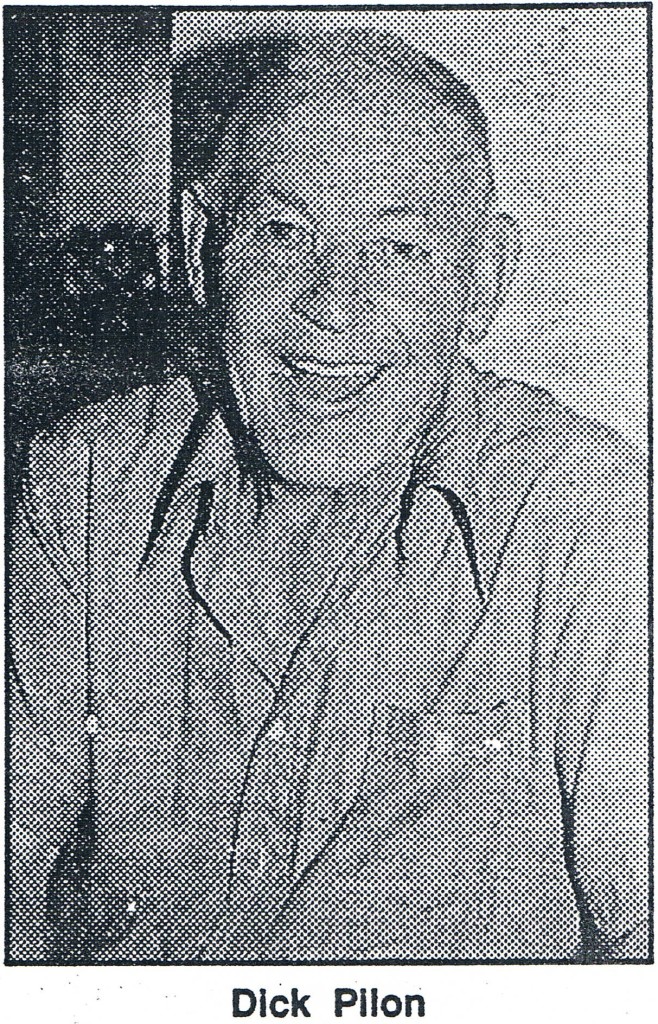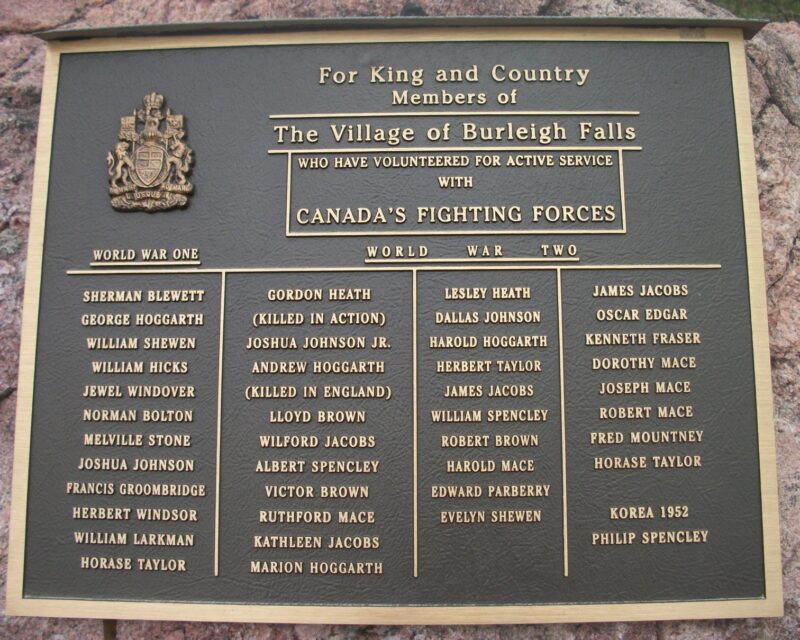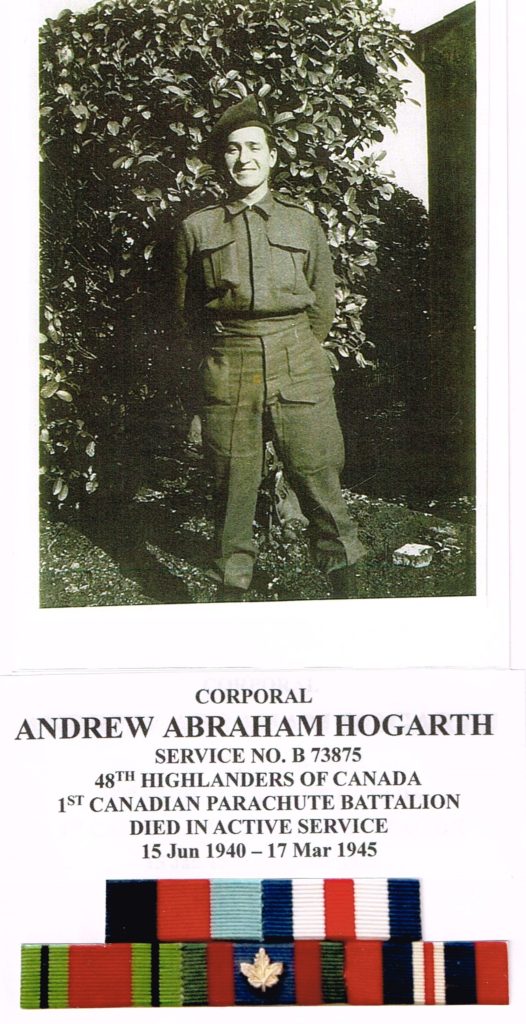MILITARY HISTORY
Corporal Andrew Abraham Hogarth — B 73875 — ACTIVE SERVICE (World War II)
Andrew, was a 19 year old single man when, on the January 15, 1940 he enlisted, in Toronto Ontario, with the 48th Highlanders of Canada, Canadian Active Service Force (CASF). He was living in Burleigh Falls Ontario at the time and gave his birth‑date as November 22, 1920 (actual date is November 9, 1921). His previous employment included being a miner and a truck driver. At the time Andrew was 5′ 8″ tall, 35″ chest, brown hair and blue eyes and weighed 140 pounds. Andrew named his mother, Mrs. Louisa Hogarth, as his next-of-kin. He entered as a Private (Pte) with Service Number B 73875 and was assigned to the 48th Highlanders of Canada (CASF), 1st Battalion Infantry.
On January 15, 1940 Pte Hogarth was taken-on-strength with the 48th Highlanders of Canada (H of C), CASF in Toronto, Ontario. February 6, 1940 Pte. Hogarth was transferred from the 48th H of C to the Infantry (Rifle) Training Centre [I (R) TC], No 2 Military District (MD), Toronto Ontario as a reinforcement recruit for basic rifle training. On February 7, 1940 he was attached for all purposes (fap) from the 48th Depot. May 10, 1940, at the end of training, Pte. Hogarth ceased attachment for all purposes from the 48th Depot and was taken-on-strength to the 48th Depot. The same day he was struck-off-strength from the 48th Depot on proceeding directly overseas from the I (R) TC, No 2 MD as Reinforcements to the 48th H of C. Pte Hogarth embarked at Halifax May 12, 1940 and was struck-off-strength from the Canadian Army (Canada) on transfer to the 48th H of C (Overseas). On May 13, 1940, he was taken-on-strength to the Canadian Army (Overseas). May 21, 1940 Pte Hogarth was taken-on-strength with the 48th H of C in Aldershot England; then on May 22, 1940 he disembarked at Liverpool, England.
On July 4, 1940 Pte. Hogarth was Attached to Headquarters (HQ) 1st Canadian Division for rations and quarters then July 12, 1940 the attachment ceased. For the next two years or so, the 48th Highlanders remained in England for training and preparation for deployment. November 24, 1940 he was granted 7 days leave, then March 8, 1941 he was granted another 7 days leave. Following these periods of leave, on May 24, 1941 he was granted 7 days Privileged Leave. On July 16, 1941 Pte. Hogarth was attached fap to the Canadian Division Weapons and Physical fitness Training (WT & PT) Camp, after a month and two days, on August 18, 1941, training and attachment ceased here and on August 19, 1941 he was attached to the Machine Gun (MG) group for rations & quarters (R&Q). On August 24, 1941 he ceased to be attached to MG for R&Q. Following three weeks of Privileged Leave (between March 14 and July 26, 1942) Pte. Hogarth attended the Royal Air Force (RAF) Station – Ringway England, Parachute Training School starting August 23, 1942. After two weeks of training he earned his parachuting wings and qualified for jump-pay.
On September 10, 1942 Pte. Hogarth transferred from the Non Effective Transit Depot (NETD) to the 48th Highlanders and embarked from the UK to Canada. Then, after disembarkation, in Canada, he had two weeks leave from September 21 to October 4, 1942. On October 7, 1942 he was transferred from the Canadian Army Overseas and attached to the Prince of Wales Own Rifles (PWOR) fap. Then on October 8, 1942 he was attached to the 1st Bn PWOR, Sherbrooke Québec pending selection, fap including pay. Then, October 8, 1942 he was attached to No 4 DD, Montréal Québec, fap including pay from No 2 DD, Toronto Ontario. On October 12, 1942 he was posted to “E” Wing, Fort Benning, Georgia USA. Pte. Hogarth was accepted in the 1st Canadian Parachute Battalion as a Rifleman or Light Machine Gunner (LMG) on October 12, 1942.
Finally, Pte. Hogarth was transferred to the 1st Canadian Parachute Station at Fort Benning “C” Wing, Georgia USA on November 20, 1942 and was attached to No 2 DD Toronto fap. On December 21, 1942 Pte, Hogarth qualified as a parachutist at Fort Benning, Georgia USA and January 5, 1943 he was entitled to draw Parachutist Pay (he also qualified at Ringway, England). In part of his training Pte. Hogath completed a course in Packing Instructions and Jump Training plus he made the required jumps from an aircraft. March 13, 1943 he was granted 14 days furlough from April 2 to April 15 1943. After training was complete, March 23, 1943 he was transferred to No 2 DD and from there he was admitted to the Central Station Hospital (CSH) in Toronto. Upon release from the CSH on April 19, 1943 he was transferred to the 4th Canadian Parachute Battalion, Camp Shilo, Manitoba [“A” Coy] effective the next day. On May 17, 1943 Pte. Hogarth had his previous furlough changed to May 22 – June 4, 1943 and on June 18, 1943 his Regimental Rate of Pay became $1.50 per diem. Pte. Hogarth was again granted an embarkation furlough from June 25 to July 3, 1943 and was no longer attached with Camp Shilo.
The ship embarked from Canada July 23, 1943 and disembarked about August 3, 1943 in the UK. On July 24, 1943 he was transferred to the Canadian Army, Overseas. Then on September 11, to September 15 he was attached to the Airborne Depot while training and then transferred to the 1st Canadian Parachute Battalion. Pte. Hogarth was awarded the Canadian Volunteer Service Medal & Bar on January 15, 1944 and the 1939 – 45 Star in May 1944.
Early on June 6, 1944 Pte. Hogarth was one of 29 Canadians in his group to parachute into France; the onset of D-Day. At 12:17 a.m. these Canadians with 200 other Allied parachutists were dropped behind enemy lines. They landed near Variville and helped to blow up four or five bridges which mostly prevented the Germans from bringing in tanks and heavy equipment. Their mission; to engage the enemy, clear roads, bridges and landing areas for the start of the main invasion; was accomplished. The main invasion was composed of ten thousand Allied paratroopers plus other support and it was to begin 15 minutes later. Severe fighting followed for four or five days and there was little food available, no time to sleep and constant mortal danger from mortars and artillery shells. After completing their mission Pte. Hogarth’s Company went to the assistance of the Black Watch Regiment which was under sever attack and badly cut up. They were exposed to severe mortar fire and shell fire. Andy Hogarth went to France on two occasions. This was Private Hogarth’s second trip to France, the first being only 22 days after arriving in England from Canada.
On June 12, 1944 Pte. Hogarth was blown up in the air by a shell blast and landed on a Bren Gun Carrier with someone on top of him. He was returned to 224 Field Ambulance, Advanced Dressing Station (A.D.S) to Casualty Clearing Station (C.C.S.) June 13, 1944 he was dazed, and his right leg was bruised and painful. The next three days indicated that there was no fracture and initially his leg was aching, he had pain in his head, he couldn’t sleep and he couldn’t walk properly. After about three days improvements and he was resting with no complaints. About June 16, 1944 Pte. Hogarth and his group were evacuated to England for a rest and further training. On June 17, 1944 Pte. Hogarth was hospitalized after being diagnosed with “Battle Exhaustion”. He was transferred to No. 1 Canadian Neurological Hospital, Basingstoke for further rest and subsequent disposal. As of June 22, 1944 his Parachutist Pay ceased and he was discharged from the 2nd Echelon 1st Canadian Parachute Battalion Hospital and returned to his Unit. He continuously insisted that he was well, fully recovered and anxiously requested to rejoin his Company in battle. Three weeks later (July 13, 1944) he was appointed Lance Corporal (L/Cpl).
L/Cpl Hogarth was involved in a traffic accident in England while driving a motorcycle from Battalion quarters to the Engineer’s Depot in Wilshire County for minor repair, at about 11:30 a.m. on March 17, 1945 he died as a result of his injuries. He was on his way to an exercise; a subsequent Court of Inquiry found that there was no blame in the accident. He is interred in Brookwood Military Cemetery, Surrey England.
L/Cpl Hogarth was promoted to Acting Lance Corporal (A/L/Cpl.) December 12, 1942 and then to Lance Corporal (L/Cpl.) January 1, 1943. However, he was reverted to Private on his own request on January 25, 1943. L/Cpl Hogarth would be promoted four more times including L/Sgt. on June 13 1943 and twice more he was reverted to Private on his own request. He even requested a permanent rank of Private but that request was ignored. He was promoted for the last time on March 17, 1945; the day of his death. On his day of discharge Andrew Abraham Hogarth was promoted to the rank of Corporal.
Cpl Hogarth served in Canada, England and France. He completed three courses with the 48th Highlanders of Canada: a Driver course in 1941, a Bren Gun Carrier Driver course in 1941 and a Sniper & Scout course in 1942. He held classifications as: an Air Drill Operator, a Driver, a Despatch Rider, a Bren Gun Carrier Driver, a Sniper & Scout, a Rifleman and a Runner. It was stated that Cpl Hogarth was “One of the best mile runners in the Canadian Army. Won everything last year.” (1943)
Cpl Hogarth was awarded the following Campaign Medals:
1939 – 45 Star;
France and Germany Star;
Defence Medal;
Canadian Volunteer Service Medal and Clasp; and
War Medal 1939 – 45.
“L/Cpl Hogarth, Andrew 1 Cdn Para Bn” is inscribed in the BOOK OF REMEMBRANCE 1945 on page 525.
Cpl Hogarth’s next-of-kin, his mother Louisa Hogarth received the following monies following his demise:
$ 125.00 in damages awarded November 1946
$1,044.10 for pay & allowances plus effects December 21, 1945
$1,007.81 a War Service Grant March 14, 1946
Total $2,176.91
An excerpt from an article in McLean’s magazine by Barbara Amiel, September 1996:
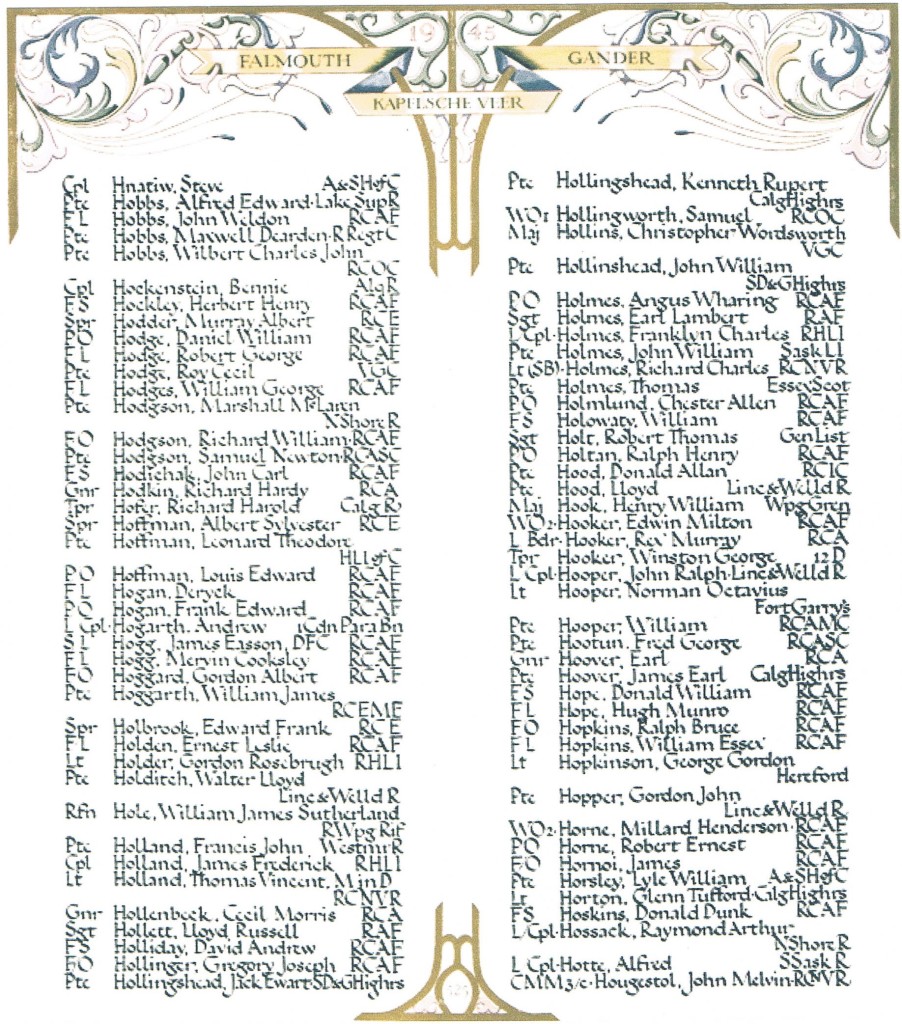
The military is the single calling in the world with job specifications that include a commitment to die for your nation. What could be more honorable?
PERSONAL HISTORY
ANDREW ABRAHAM HOGARTH
Andrew (Andy) Hogarth was born the first child of George Hoggarth and Hanna Louise Taylor on November 19, 1920 (sometimes stated as being November 22, 1920) on the Ojibway First Nations Reserve, Curve Lake, Ontario. Worthy of note is that the father, George, spelled his name with “two g’s” and that some of his children, including Andy, either by intent or error, adapted to the one “g”. Hence the family continues to evolve with both spellings.
Shortly after Andy’s birth, the Hogarths relocated to Burleigh Falls. Andy, a good looking boy with dark wavy hair, was known to be very active. In those times, Lovesick Lake and Burleigh Falls were distant from most all educational facilities, and on the few occasions which formal education was available, Andy found it very difficult to accept this rigidity and confinement. Hence most of his time was spent swimming, fishing, hunting, camping, canoeing and playing sports such as softball and hockey. Father George, when possible, assisted with home schooling in the basics of education. Despite the lack of formal education Andy became literate, developing plain and legible handwriting, giving some indication that he possessed an above average level of intelligence.
Andy liked school but left school to work at a young age; he was a truck driver and a miner. From 1931 to 1935 [10 – 15 years old], he worked for Johnson Construction Company, Brantford Ontario for $30.00 per week. Then from 1935 to 1940 he was a truck driver for $20.00 per week in the Burleigh Falls area. Andy also worked in a mine as an assistant air drill operator; he had 1st Class Miner’s papers. According to his military records, Andy spoke English, Cree and Mohawk and wrote English.
Andy was noted as being exceptionally strong for his size, and a very agile, speedy runner. He was always known as being capable, brave and daring. One such example is the story of Andy making several pleas to a Trent Canal underwater diver, named Sammy, to use the diving equipment and go ‘down under’. Eventually, Sammy, reluctantly agreed, but knowing he could lose his job, he made Andy promise to never tell anyone! Without doubt this daring feat was but one indication of his future role and conduct in the army.
A boyhood friend, Bob Brown, of Burleigh Falls, relates this story of Andy. An American visitor, vacationing at Viamede resort, had harassed and abused some young Burleigh girls. Andy, who was about 15 years of age, was told of this and asked Bob to accompany him to visit the offending party. Upon arrival they found that the American was not only older, but much bigger than Andy, and quite insolent about the matter. Bob, now 90 plus years of age says: “Andy quickly showed him that it isn’t the size of the boy in the fight, but the size of the fight in the boy” as he thoroughly thrashed him, and quickly resolved this, and any future affront to the locals from that source.
While Andy continued to live at home he would work, in season, as a fishing guide for American tourists in the area lakes, which he had come to know so well. For a few years he was able to find work with Johnston Construction Co. of Brantford who were building the Burleigh – Apsley Highway. As well, Andy loved to hunt. He had a fox hound ‘Andy’, the naming of which demonstrated his sense of humour. Andy proclaimed to all: “When I get to sell enough fox hides I am going to Toronto and join the Army”. And so he did, signing up in Toronto with the 48th Highlanders January 15, 1940. At enlistment he was 19 years old, single, 5’8″ in height, and weighed 140 pounds. Andy’s brother, Harold, next in age to Andy, would also join the Canadian Army, serving as a tank gunner in an armoured regiment.
While en-route to the UK in May 1940, crossing the Atlantic on a troopship of thousands of soldiers, Andy won the boxing championship in his weight class. Unknown as to it’s location now, but for many years a prized possession of his family, was a newspaper photo of Andy, the winner of a ten mile race, when being congratulated by King George the V1. On another occasion, Andy is shown in a team photo dated August 23rd, 1941, as being part of the Track and Field team, champions of all the Canadian Forces. His military records describe him as being “one of the fastest runners in the Canadian army”, and he is listed as having won the Dominion Army mile race championship in 1940‑41, and 1943. Always retaining the fond memories and love of his family, Andy directed $20.00 per month of his $1.50 per diem pay ($45.00 per month) home to his mother
Andy was granted two furloughs in May/June 1943 prior to being shipped overseas, on at least one of these furloughs Andy was able to visit home in Burleigh Falls, Ontario. As events would later unfold, and unknown to him, this would be the last occasion in which Andy would see and enjoy his family and home area.
Attached is an interview of a surviving fellow paratrooper, R. E. ‘Dick’ Pilon, one of the 29 Canadian fellow paratroopers. This interview, in commemoration of the 50th anniversary of D-Day, was published in the Peterborough Examiner on June 6, 1994. Included also are pictures of the 29 brave, well trained Canadian heroes. Andy Hogarth, a Private at the time, is pictured to the right of Mr. Pilon. It is stated that Andy was from Toronto which is obviously incorrect. However many servicemen were described as being from their city of enlistment, rather than their actual home town. It is indeed fortunate that we discovered Mr. Pilon’s interview. There is no doubt whatsoever that Andy Hogarth’s experiences would be very similar, and would parallel those described in the interview.
Andy died on March 17, 1945, age 24, as a result of a motorcycle accident in England. A collision ensued when a civilian operated auto, towing a utility trailer, made a turn without warning in front of the motorcycle. Andy Hogarth sustained head injuries resulting in his death. The findings of a military court of inquiry stated that Corporal Hogarth was not to blame for the accident. Andy Hogarth is buried in Brookwood Military Cemetery, Surrey, England located about 30 miles from London.
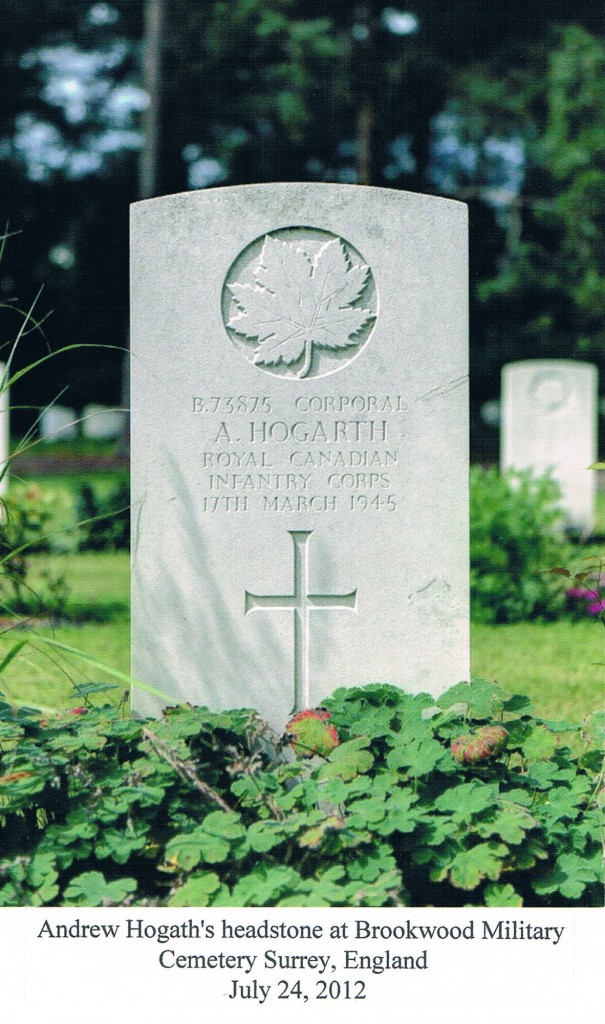
Regretfully, Andy would never return home. Also, due to the strict existing war time censorship, never was he allowed to relate any of his experiences to his family.
At the time of his demise, Andy had been courting and was intending to marry an English girl. The Hogarth family had not been fully aware nor advised of the relationship. However, some few years after the war, the lady had become a medical doctor, and was practicing for a short while in Hamilton, Ontario. Following contact with the Hogarth parents and family, an extremely pleasant, welcome, and rewarding event to all involved was her visit of a week or more in Burleigh Falls.
These few paratroopers, of which Andy was part, were a brave, elite, well trained, select group. Andy had made 36 successful jumps and stated that he was never ever nervous about so doing. They were well aware of the danger and peril of their missions, that of always being the first-wave of assault troops. Indeed they would be schooled and quite aware that their assault would involve the entering of dangerous territory known to be both occupied and fortified by the enemy. Information gained from his military records reveal that Andy’s courage and leadership abilities were both well known and noted by his superiors. As result Andy received several promotions, all of which he respectfully declined. His final promotion to Corporal was an honour granted on the date of his death, and only then was Andy unable to refuse same. Hence you will have understanding as to the reason Andy is referred to as both ‘Private’ and ‘Corporal’ in this narrative. We understand that these refusals of promotion supported his belief that there was no more noble calling or reward than to be a ‘warrior’.
The money ($2,176.91 see Military History), eventually paid to Andy’s mother following his death, appears to have taken a lengthy period, even with the allowance that it was wartime. Records indicate that Mr. Gordon K. Fraser, the Federal member of Parliament for the riding of Peterborough, intervened, on behalf of the parents, to accelerate the payments. Mr. Fraser lived at Burleigh Falls and was no doubt friendly with, and well known to, the Hogarth family.
We note that Andy was classed as “one of the best mile runners in the Canadian Army”. This was indeed a tremendous feat in that Canada had more than 700,000 soldiers in service at that time. One is left to ponder how the future may have unfolded. Certainly there would have been improvement through proper nutrition, coaching and training, none of which had been available, or even touched upon in the pre-war Burleigh area. Andy, if willing, and with this intensified development of his ample natural ability, may well have become a member of our Canadian Olympic team.
We, from the area of Lakefield, Curve Lake and Burleigh Falls are very proud to know of Andy Hogarth. We shall remember a local boy, one of our own, through his heroic contribution, and his sacrifice to ensure our freedoms.
LET US NOT FORGET
THE ANDREW HOGARTH FAMILY OF CURVE LAKE ONTARIO
Andrew’s father George Douglas Hoggarth was born in Peebles, a royal burgh in Tweeddale near Edinburgh, Scotland on October 12, 1891, the son of Mr. and Mrs. John Hoggarth. He immigrated to Canada in 1912, first coming to Toronto and then to Lakefield where he worked on the building of the Canada Cement factory. George Douglas went by the nickname “Scotty”.
On September 25, 1914 he enlisted in Valcartier, Québec as a Private with the 1st Canadian Remount Depot, Canadian Expeditionary Force (Over-Seas). George returned home in June of 1919 and settled in Curve Lake, Ontario. George, 29, married Hannah “Louise” Taylor, 18; daughter of Abraham and Nellie Taylor, a First Nations native of the Curve Lake Reservation. George and Louise had a family of nine children: Andrew “Andy” Abraham; Harold Douglas; Jean; George (Jr); Charles; John “Jack”; Donald; Pearl; Helen Louise and Clifford.
Around 1921, the family moved to Burleigh Falls and George worked for the Trent-Severn Canal System. He eventually became lockmaster at Lovesick Lake and Burleigh Falls until his retirement. At both Canal locations, the family lived in the lockmaster’s house provided as a job benefit by the Trent-Severn Canal System.
George Douglas Hoggarth died on May 1, 1961 and is buried in the Curve Lake Cemetery.
LUCKY TO BE ALIVE
Paratrooper among first in Normandy
Veteran returns to become Queen Elizabeth (Public School in Peterborough)
school custodian
Ask Dick Pilon about the Invasion of Normandy and he talks about his luck.
He was lucky to be the sole applicant of 40 in his battalion to qualify for the First Canadian Parachute Battalion, lucky to be among the first D- Day invaders in France and after three months of fighting and living in trenches – lucky to leave alive.
The 70-year-old War veteran lived and fought in horrible conditions. Decaying corpses of soldiers from both sides and livestock littered the streets and rubble of bombed buildings.
Pilon saw his comrades wounded, killed and driven out of their minds by constant shelling, especially the infamous Moaning Minnie bombs that “sounded like the sirens of 50 fire trucks all at once.”
But those are things Pilon only mentions, provided the listener pries the grizzly details from him.
Instead, he talks about his vast collection of humorous and interesting experiences: meeting an enemy ‘soldier born and raised in California, sharing a bottle of wine with French civilians, being welcomed by a jubilant six-year-old French boy and finding the only buildings left on a street after an Allied aerial bombing of Caen were a church and a brothel.
“There was hardly a day that went by that we weren’t shelled with Moaning Minnies or mortars. Every time Billy Chaddock and I dug our fox hole a little deeper.
“One day we were called out to help the Black Watch from being overrun. When I returned (Chaddock was shot and didn’t make it back) I found I was lucky again. Our fox hole had taken a direct (bomb) hit.”
Pilon, who was chief custodian at Central Elementary School for 26 years before retiring in 1989, was born and: raised at Exeter near London, Ontario.
He was at Newmarket training camp when he qualified for the famed parachute battalion, known as Death of the Glory Boys.
In-his collection of memorabilia is a magazine article featuring photographs of him and 29 of his fellow paratroopers, the first Canadians in France on D-Day.
They and more than 200 other Allied troops were dropped behind enemy lines at 12:17 a.m. June 6, 1944. Their job was to clear the way for the main invasion 15 minutes later, but they landed in flooded farm fields five miles off course.
When the invasion came they could only watch the spectacular fire show of tracer bullets; anti-aircraft fire, explosions and burning planes plummeting to earth.
“It was the greatest fireworks show ever. I watched for a moment, but we had things to do. It was horrible. Those were our buddies being killed.”
Wading through waste-deep water, Pilon made his way to a hedgerow, where in the moon- light he could make out two men moving toward him.
“I didn’t know who they were. I was in water up to my neck. In one hand I held a grenade, the pin pulled, and in the other my cricket clicker. I clicked once and hearing a two-click reply (indicating friend) was a feeling of relief hard to put into words.”
The men eventually found a wounded British soldier. He and another Brit fired at each other, each thinking the other was the enemy. They were too far apart to hear the clickers, Pion said.
Pilon took over the wounded soldier’s Bren gun and 200 rounds of ammunition, which brought him to the attention of British Brigadier Hill and almost cost him his life at the bottom of the Orin River.
Upon seeing Pilon with the machine gun, Brigadier Hill asked him to take the point for their group of about 40 British soldiers.
Pilon had become separated in the dark from the Canadian troops and didn’t join up with them until 6 a.m. when they reached Variville, a small village where they were supposed to have been dropped the night before.
Reaching Variville meant each soldier had to pull himself across the Orm River using toggle ropes stretched from one side to the other.
And, being point man meant Pilon crossed first.
“With the Bren and all the extra ammunition you can imagine what happened, and it happened fast. I went straight to the bottom, well over my head.”
Upon reaching Variville, the paratroopers took out a German pill box and secured a line of enemy trenches near a pottery factory.
It became Pilon’s home for the next two to three months until a shrapnel wound to his leg brought his War to an end.
